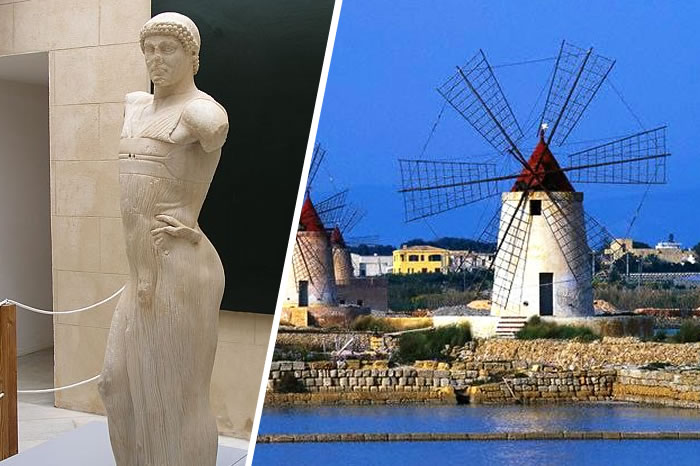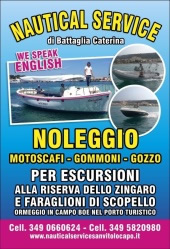

Motya: Visit of Hector and Infersa and windmill. Transfer and visit the island of Mozia Whitaker museum, fortifications, Thopet, Cothon.Marsala: panoamico tour of the city. (4 hours)
Mozia or Motya looks like a flat island, rather small (40ha), covered by olive trees and vineyards, in the middle of the Lagoon, the sea area from the Island Long closed. The foundation is therefore measured in the mid-eighth century. It would therefore born as a commercial station.
In 397 a. C, it was conquered and destroyed by Dionysius I of Syracuse and the inhabitants took refuge on the mainland, at Lilybaeum (Marsala).
Joseph Whitaker, at the beginning of the century, bought the island and we began excavations that proved very interesting for the knowledge of the Phoenician civilization.
According to the testimony of the historian Diodorus of Sicily, Mozia was a beautiful and rich city of palaces, perhaps, he exaggerated the urban dimension of Mozia, deceived by its strategic importance.
The excavations carried out to date have in fact brought to light a few remnants of the town: the walls of buildings aligned along a road oriented in direction of the northwest, southeast and the "house of the amphorae" in the central sector. It is believed that the city has an axial development, with arteries that are crossed at right angles, forming a grid of streets. main artery was to link North Door with South Gate. At South Gate there are the ruins of a building, perhaps a military quarter, while in the vicinity of the museum are the ruins of the "House of the Mosaics": beautiful mosaics made of small pebbles whites and blacks depict hunting scenes between animals.
Near the landing stands the villa of Whitaker housing a museum on the island: in it arouses great interest the statue of the "youth" of Mozia, 1.81 m high. and made of white marble from Asia Minor.
Near South Gate, opens the artificial inlet of cothon, a pool of rectangular shape approximately 50 x 40 meters, whose function is still debated: it has long been regarded as the port of Mozia where the ships came with the goods or where they took shelter from storms; this hypothesis is refuted by the same size as the cothon and those of its opening which is only a few meters wide.
More likely it is that the cothon was a basin for a few meters boats loading and unloading goods from the Phoenician ships remained moored in Stagnone sea. Excavations in the north have come to light the remains of significant industrial facilities for the activity of the potters, as evidenced by the presence of ovens in the so called K area, or used for dyeing and tanning leather and fabrics. The walls were restored and partially reconstructed in some places. In them they opened frequent posterns and barracks for surveillance; Interestingly the presence in the North door of three "dipyla" ie three sets of double doors systems, supported by a single central pillar.
The outer Dipylon was probably topped by a sculptural group, preserved at the museum, which depicts a bull mauled by two lions and that recalls that of the Lion Gate at Mycenae. Outside the north gate is submerged for bradyseism, a paved road that connected the island to the mainland and that it was even a few years ago a natural way of communication for access to the island of wagons loaded with grapes.
Much of the archaeological material was discovered in the two necropolis of Mozia: the oldest, VIII-VI century. C., is located in the north-west; the other VI-V century, is located on the mainland, along the coast of Birgi. In the necropolis of Birgi they came to light several tombs reflecting the interment rite that moziesi began to practice from the sixth century.
Among the ancient necropolis and North Gate is a vast complex of buildings from various periods in square blocks, called Cappiddazzu. In the ruins they recognize the remains of a square enclosure and a building with three naves leaning against it; maybe the place had religious function, given the presence of small stone altars.
Near the ancient necropolis are the remains of the Tophet, the sanctuary where he performed the sacrifices of the firstborn males. The Tophet, was an outdoor structure where only the priests had access; even today, they outweigh the votive stelae and memorial stones commemorating places of the victims, but also wells and the remains of a small temple construction. The last layer of cinerari findings can be deduced that this was perpetuated for a long time, from the seventh to the fourth century advanced. By symbolic representations of votive stelae and some inscriptions in Punic of them reported it has been established that the most venerated by moziesi deity was Baal Hammon, whose sanctuary was probably dedicated.
-----------------------------
Marsala is a town of 82,322 inhabitants in the province of Trapani, on the west coast of Sicily; It is the fifth most populated city in Sicily (after Palermo, Catania, Messina and Syracuse), and the 63rd largest city in Italy, [1] as well as the largest agricultural, industrial and commercial center of the province of Trapani. And ´City of Wine, because only and only here will you produce the eponymous dessert wine. And ´after Palermo, the second largest city in Western Sicily, and aspires to be almost one hundred years to become the provincial capital. It located on almost all the ruins of the ancient Punic city Lilybaeum, and hence the name "lilbetani" of its inhabitants. Lorenzo Carini is the first center-right mayor of the city since the Italian Constitution; Marsala, in fact, has always been governed by the left, particularly the Socialists in the 70s and 80s. For this reason, it has always been considered a stronghold of the Left.
In the 250 square km of extension has a rich cultural heritage and landscape. It aspires for decades to be the provincial capital. It built on the ruins of the ancient Lilybaeum, Carthaginian city, and its territory includes the regional nature reserve of the Islands of the Lagoon of Marsala.
Its foundation is closely linked with that of Mozia, one of the islands, founded in VIII BC, which was a major Phoenician city. Is the world capital of Archaeology Naval [citation needed], as in the Museum of Baglio Anselmi are guarded the remains of a Punic ship, unique archaeological find in the world of combat vessel; dating back to 241 BC, the year of the Punic Wars fought in front of the sea of Lilybeo. During the first of the three Punic wars, he was besieged by the Romans and defended by the Punic commander Himilco. From here the historic siege of Lilybaeum, which prevailed just the Romans.
Currently, after decades of wild construction and careless administration of its assets, it is in progress the construction of the archaeological park or the excavation of a large area of the city, has always guarded by the institutions but never excavated, which is the area where there was the ´ Danica Carthaginian city before, and then Roman, of Lilybaeum. Excavations were begun in the 70s with reinvenimento Roman insula. The 2000s are marking a turning point: not least the decumannus discoveries, the Venus Callipige of the second century and numerous traces of ancient civilizations (mortuaries, flooring, tools, remains of houses and streets). In particular, in 2007, in the excavation of St. John, the sixteenth floor of the church was found, and in the excavation adjacent to it, a collapsed column on a pavement of white marble. In all excavations of the area, the visible layers of earth are a mix of earth and clay pieces, vases, coins, and various signs of ancient civilizations.



SicilDriver è transfer e servizi professionali taxi e navetta per il turista per tutte le più belle località della Sicilia: San Vito lo Capo,Trapani,Erice,Marsala, Castellammare del Golfo, Segesta,Selinunte, Isole Egadi(Favignana,Levanzo, Marettimo),Mazara del Vallo, da e per gli aereoporti di Trapani Birgi(Vincenzo Florio) in coincidenza con arrivi dei Voli Ryanair e Palermo Punta Raisi(Falcone e Borsellino).
Via Villa Rosina, 115 - 91100 Trapani
Tel. +39 347 12.90.467 | Email: sicildriver@gmail.com